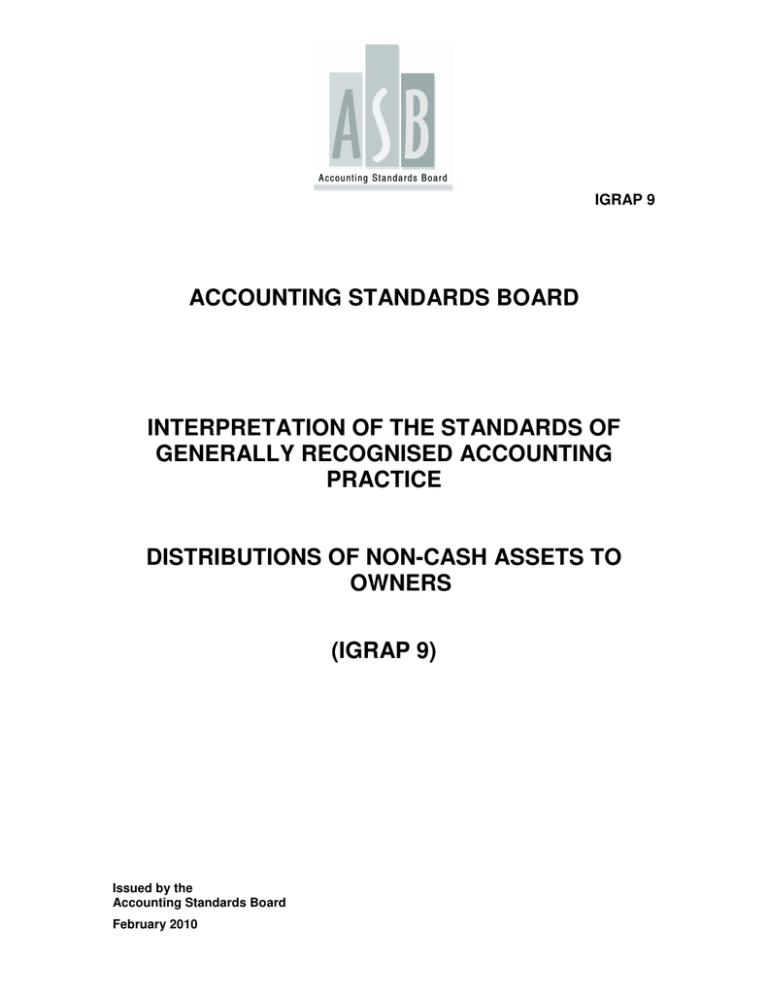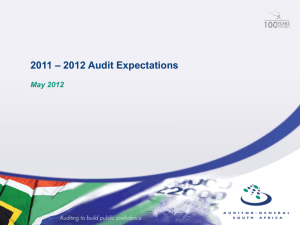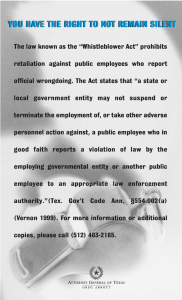
IGRAP 9
ACCOUNTING STANDARDS BOARD
INTERPRETATION OF THE STANDARDS OF
GENERALLY RECOGNISED ACCOUNTING
PRACTICE
DISTRIBUTIONS OF NON-CASH ASSETS TO
OWNERS
(IGRAP 9)
Issued by the
Accounting Standards Board
February 2010
IGRAP 9
Acknowledgement
This Interpretation of the Standards of Generally Recognised Accounting Practice (IGRAP)
is drawn primarily from the equivalent Interpretation of the International Financial
Reporting Standard on Distributions of Non-cash Assets to Owners (IFRIC 17) issued by
the International Financial Reporting Interpretations Committee (IFRIC) of the International
Accounting Standards Board (IASB). The IASB has issued a comprehensive body of
IFRICs. Extracts of the IFRIC on Distributions of Non-cash Assets to Owners are
reproduced in these Interpretations of the Standards of GRAP with the permission of the
IASB.
The approved text of IFRSs is that published by the IASB in the English language and
copies may be obtained from:
IASB Publications department
7th floor, 166 Fleet Street
London ED4A 2DY
United Kingdom
Internet: http://www.iasb.org.uk
Copyright on IFRSs, interpretations, exposure drafts and other publications of the IASB
are vested in the International Accounting Standards Committee Foundation (IASCF) and
terms and conditions attached should be observed.
Accounting Standards Board
P O Box 74129
Lynnwood Ridge
0040
Copyright ©2010 by the Accounting Standards Board
All rights reserved. No part of this publication may be reproduced, stored in a retrieval
system, or transmitted, in any form or by any means, electronic, mechanical,
photocopying, recording, or otherwise, without the prior permission of the Accounting
Standards Board.
Permission to reproduce limited extracts from the publication will not usually be withheld.
Issued February 2010
2
Distributions of Non-cash
Assets to Owners
IGRAP 9
DISTRIBUTIONS OF NON-CASH ASSETS TO OWNERS
Introduction
Interpretations of the Standards of Generally Recognised Accounting
Practice
The Accounting Standards Board (Board) is required in terms of the Public Finance
Management Act, Act No. 1 of 1999, as amended (PFMA), to determine generally
recognised accounting practice referred to as Standards of Generally Recognised
Accounting Practice (GRAP).
The Board must determine GRAP for:
(a)
departments (national and provincial);
(b)
public entities;
(c)
constitutional institutions;
(d)
municipalities and boards, commissions, companies, corporations, funds or other
entities under the ownership control of a municipality; and
(e)
Parliament and the provincial legislatures.
The above are collectively referred to as “entities”.
The Board has approved the application of Statements of Generally Accepted Accounting
Practice (GAAP), codified by the Accounting Practices Board (APB) and issued by the
South African Institute of Chartered Accountants (SAICA) to be GRAP for:
(a)
government business enterprises (GBEs)(as defined in the PFMA);
(b)
trading entities (as defined in the PFMA);
(c)
any other entity, other than a municipality, whose ordinary shares, potential
ordinary shares or debt are publicly traded on the capital markets; and
(d)
entities under the ownership control of any of these entities.
The Board believes that Statements of GAAP are relevant and applicable to financial
statements prepared by all such entities including those under their ownership control.
Financial statements should be described as complying with Standards of GRAP only if
they comply with all the requirements of each applicable Standard of GRAP and any
related Interpretations of the Standards of GRAP.
Any limitation of the applicability of specific Standards or Interpretations of the Standards
of GRAP is made clear in those Standards or Interpretations of the Standards of GRAP.
The Interpretation of the Standard of GRAP on Distributions of Non-cash Assets to
Owners is set out in paragraphs .01 to .20. All paragraphs in this Interpretation of the
Issued February 2010
3
Distributions of Non-cash
Assets to Owners
IGRAP 9
Standards of GRAP have equal authority. The status and authority of appendices are dealt
with in the preamble to each appendix. This Interpretation of the Standards of GRAP
should be read in the context of its objective, its basis for conclusions if applicable, the
Preface to Standards of GRAP, the Preface to the Interpretations of the Standards of
GRAP and the Framework for the Preparation and Presentation of Financial Statements.
Standards of GRAP and Interpretations of Standards of GRAP should also be read in
conjunction with any directives issued by the Board prescribing transitional provisions, as
well as any regulations issued by the Minister of Finance regarding the effective dates of
the Standards of GRAP, published in the Government Gazette.
Reference may be made to a Standard of GRAP that has not been issued at the time of
issue of this Interpretation of the Standards of GRAP. This is done to avoid having to
change the Standards already issued when a later Standard is subsequently issued.
Paragraph .12 of the Standard of GRAP on Accounting Policies, Changes in Accounting
Estimates and Errors provides a basis for selecting and applying accounting policies in the
absence of explicit guidance.
Issued February 2010
4
Distributions of Non-cash
Assets to Owners
IGRAP 9
Interpretation of the Standards of GRAP on Distributions of Non-cash
Assets to Owners
References
•
GRAP 1 Presentation of Financial Statements (as revised in 2010)
•
GRAP 6 Consolidated and Separate Financial Statements
•
GRAP 14 Events after the Reporting Date (as revised in 2010)
•
GRAP 100 Non-current Assets Held for Sale and Discontinued Operations (as
revised in 2010)
•
GRAP 104 Financial Instruments
•
The Standard of GRAP on Entity Combinations
Background
.01
Sometimes an entity distributes assets other than cash (non-cash assets) as
dividends or similar distributions to its owners acting in their capacity as owners.
In those situations, an entity may also give its owners a choice of receiving either
non-cash assets or a cash alternative.
.02
Standards of GRAP do not provide guidance on how an entity should measure
dividends or similar distributions to its owners. The Standard of GRAP on
Presentation of Financial Statements (as revised in 2010) requires an entity to
present details of dividends or similar distributions recognised as distributions to
owners either on the face of the statement of financial performance or in the
statement of changes in net assets or in the notes to the financial statements.
Scope
.03
This Interpretation of the Standards of GRAP applies to the following types of
non-reciprocal distributions of assets by an entity to its owners acting in their
capacity as owners:
(a) distributions of non-cash assets (e.g. items of property, plant and equipment,
entity combinations as defined in the Standard of GRAP on Entity
Combinations, ownership interests in another entity or disposal groups as
defined in the Standard of GRAP on Non-current Assets Held for Sale and
Discontinued Operations (as revised in 2010)); and
(b) distributions that give owners a choice of receiving either non-cash assets or a
Issued February 2010
5
Distributions of Non-cash
Assets to Owners
IGRAP 9
cash alternative.
.04
This Interpretation of the Standards of GRAP applies only to distributions in which
all owners of the same class of residual interests are treated equally.
.05
This Interpretation of the Standards of GRAP does not apply to a distribution of a
non-cash asset that is ultimately controlled by the same party or parties before
and after the distribution. This exclusion applies to the separate, individual and
consolidated financial statements of an entity that makes the distribution.
.06
In accordance with paragraph .05, this Interpretation of the Standards of GRAP
does not apply when the non-cash asset is ultimately controlled by the same
parties both before and after the distribution. The Standard of GRAP on Entity
Combinations states that ‘A group of individuals shall be regarded as controlling
an entity when, as a result of binding arrangements, they collectively have the
power to govern its financial and operating policies so as to obtain benefits from
its activities.’ Therefore, for a distribution to be outside the scope of this
Interpretation of the Standards of GRAP on the basis that the same parties control
the asset both before and after the distribution, a group of individual owners
receiving the distribution must have, as a result of binding arrangements, such
ultimate collective power over the entity making the distribution.
.07
In accordance with paragraph .05, this Interpretation of the Standards of GRAP
does not apply when an entity distributes some of its ownership interests in a
controlled entity but retains control of the controlled entity. The entity making a
distribution that results in the entity recognising a minority interest in its controlled
entity accounts for the distribution in accordance with the Standard of GRAP on
Consolidated and Separate Financial Statements.
.08
This Interpretation of the Standards of GRAP addresses only the accounting by
an entity that makes a non-cash asset distribution. It does not address the
accounting by owners who receive such a distribution.
Issues
.09
When an entity declares a dividend or similar distribution and has an obligation to
distribute the assets concerned to its owners, it must recognise a liability for the
dividend or similar distribution payable. Consequently, this Interpretation of the
Standards of GRAP addresses the following issues:
(a) When should the entity recognise the dividend or similar distribution payable?
(b) How should an entity measure the dividend or similar distribution payable?
(c) When an entity settles the dividend or similar distribution payable, how should
it account for any difference between the carrying amount of the assets
Issued February 2010
6
Distributions of Non-cash
Assets to Owners
IGRAP 9
distributed and the carrying amount of the dividend or similar distribution
payable?
Consensus
When to recognise a dividend or similar distribution payable
.10
The liability to pay a dividend or similar distribution shall be recognised when the
dividend or similar distribution is appropriately authorised and is no longer at the
discretion of the entity, which is the date when the dividend or similar distribution
is declared by management.
Measurement of a dividend or similar distribution payable
.11
An entity shall measure a liability to distribute non-cash assets as a dividend or
similar distribution to its owners at the fair value of the assets to be distributed.
.12
If an entity gives its owners a choice of receiving either a non-cash asset or a
cash alternative, the entity shall estimate the dividend or similar distribution
payable by considering both the fair value of each alternative and the associated
probability of owners selecting each alternative.
.13
At the end of each reporting period and at the date of settlement, the entity shall
review and adjust the carrying amount of the dividend or similar distribution
payable, with any changes in the carrying amount of the dividend or similar
distribution payable recognised in net assets as adjustments to the amount of the
distribution.
Accounting for any difference between the carrying amount of the assets
distributed and the carrying amount of the dividend or similar distribution
payable when an entity settles the dividend or similar distribution payable
.14
When an entity settles the dividend or similar distribution payable, it shall
recognise the difference, if any, between the carrying amount of the assets
distributed and the carrying amount of the dividend or similar distribution payable
in surplus or deficit.
Presentation and disclosures
.15
.16
An entity shall present the difference described in paragraph .14 as a separate line
item in surplus or deficit.
An entity shall disclose the following information, if applicable:
Issued February 2010
7
Distributions of Non-cash
Assets to Owners
IGRAP 9
(a) the carrying amount of the dividend or similar distribution payable at the
beginning and end of the period; and
(b) the increase or decrease in the carrying amount recognised in the period in
accordance with paragraph .13 as result of a change in the fair value of the
assets to be distributed.
.17
If, after the end of a reporting period but before the financial statements are
authorised for issue, an entity declares a dividend or similar distribution to
distribute a non-cash asset, it shall disclose:
(a) the nature of the asset to be distributed;
(b) the carrying amount of the asset to be distributed as of the end of the
reporting period; and
(c) the estimated fair value of the asset to be distributed as of the end of the
reporting period, if it is different from its carrying amount, and the information
about the method used to determine that fair value required by the Standard
of GRAP on Financial Instruments.
Transitional provisions
.18
All changes resulting from the application of this Interpretation of the
Standards of GRAP shall be accounted for in accordance with the
requirements of the Standard of GRAP on Accounting Policies, Changes in
Accounting Estimates and Errors (as revised in 2010). This Interpretation of
the Standards of GRAP shall only be applied to those distributions of noncash assets to owners that occurred after 1 April 2010.
Effective date
Initial adoption of the Standards of GRAP
.19
This Interpretation of the Standards of GRAP becomes effective with
reference to the effective date of the applicable Standards of GRAP as
determined by the Minister of Finance in a regulation to be published in
accordance with section 91(1)(b) of the Public Finance Management Act, Act
No. 1 of 1999, as amended.
Entities already applying Standards of GRAP
.20
An entity shall apply this Interpretation of the Standards of GRAP for annual
financial statements covering periods beginning on or after 1 April 2011.
Issued February 2010
8
Distributions of Non-cash
Assets to Owners
IGRAP 9
Appendix – Consequential amendments to other Standards of GRAP
The purpose of the appendix is to identify the consequential amendments to other
Standards of GRAP resulting from the issue of this Interpretation of the Standards of GRAP.
Amended text is shown with new text underlined and deleted text struck through.
Amendments to Standards of GRAP
The Standard of GRAP on Non-current Assets Held for Sale and
Discontinued Operations (as revised in 2010)
Scope
Paragraph .06 is to be amended as follows:
.06A
The classification, presentation and measurement requirements in this Standard
applicable to a non-current asset (or disposal group) that is classified as held for
sale apply also to a non-current asset (or disposal group) that is classified as
held for distribution to owners acting in their capacity as owners (held for
distribution to owners).
Classification of non-current assets (or disposal groups) as held for sale or as held
for distribution to owners
Paragraph .10 and .14 are to be amended as follow:
.10
For the sale to be highly probable, management must be committed to a plan to
sell the asset (or disposal group), and an active programme to locate a buyer
and complete the plan must have been initiated. Further, the asset (or disposal
group) must be actively marketed for sale at a price that is reasonable in
relation to its current fair value. In addition, the sale should be expected to
qualify for recognition as a completed sale within one year from the date of
classification, except as permitted by paragraph .11, and actions required to
complete the plan should indicate that it is unlikely that significant changes to
the plan will be made or that the plan will be withdrawn.
.14A
A non-current asset (or disposal group) is classified as held for distribution to
owners when the entity is committed to distribute the asset (or disposal group)
to the owners. For this to be the case, the assets must be available for
immediate distribution in their present condition and the distribution must be
highly probable. For the distribution to be highly probable, actions to complete
the distribution must have been initiated and should be expected to be
completed within one year from the date of classification. Actions required to
Issued February 2010
9
Distributions of Non-cash
Assets to Owners
IGRAP 9
complete the distribution should indicate that it is unlikely that significant
changes to the distribution will be made or that the distribution will be
withdrawn.
Measurement of non-current assets (or disposal groups) classified as held for sale
Paragraph .17 is to be amended as follows:
.17A
An entity shall measure a non-current asset (or disposal group) classified as
held for distribution to owners at the lower of its carrying amount and fair value
less costs to distribute .
The Standard of GRAP on Events after the Reporting Date (as revised in
2010)
Paragraph .13 is to be amended as follows:
Dividends or similar distributions
.13
If dividends or similar distributions to owners are declared (ie the dividends or
similar distributions are appropriately authorised and no longer at the discretion
of the entity) after the reporting date but before the financial statements are
authorised for issue, the dividends or similar distributions are not recognised as
a liability at the end of the reporting date because no obligation exists at that
time they not meet the criteria of a present obligation in the Standard of GRAP
on Provisions, Contingent Liabilities and Contingent Assets. Such dividends or
similar distributions are disclosed in the notes in accordance with the Standard
of GRAP on Presentation of Financial Statements (as revised in 2010).
Dividends or similar distributions do not include a return of capital.
1
Costs to distribute are the incremental costs directly attributable to the distribution excluding finance costs and income tax
expense, where applicable.
Issued February 2010
10
Distributions of Non-cash
Assets to Owners
IGRAP 9
Appendix
Illustrative examples
This appendix is illustrative only and does not form part of the Interpretation of the
Standards of GRAP. The purpose of the appendix is to illustrate the application of the
Interpretation of the Standards of GRAP to assist in clarifying its meaning.
Scope of the Interpretation of the Standards of GRAP (paragraphs .03 to
.08)
CHART 1
Before distribution
Public owners
Entity A
After distribution
Public owners
Entity A
Assets
IE1
Assume Entity A is owned by public owners. No single owner controls Entity A
and no group of owners is bound by a binding agreement to act together to
control Entity A jointly. Entity A distributes certain assets pro rata to the owners.
This transaction is within the scope of this Interpretation of the Standards of
GRAP.
IE2
However, if one of the owners (or a group bound by a binding agreement to act
together) controls Entity A both before and after the transaction, the entire
transaction (including the distributions to the minority owners) is not within the
scope of this Interpretation of the Standards of GRAP. This is because in a pro
rata distribution to all owners of the same class of residual interests, the
controlling owner (or group of owners) will continue to control the non-cash
assets after the distribution.
Issued February 2010
11
Distributions of Non-cash
Assets to Owners
IGRAP 9
CHART 2 (distribution of shares of controlled
entities
Before distribution
Public owners
Entity A
After distribution
Public owners
Entity A
Controlled
entity B
Controlled
entity B
IE3
Assume Entity A is owned by public owners. No single owner controls Entity A
and no group of owners is bound by a binding agreement to act together to
control Entity A jointly. Entity A owns all of the shares of controlled entity B.
Entity A distributes all of the shares of controlled entity B pro rata to its owners,
thereby losing control of controlled entity B. This transaction is within the scope
of this Interpretation of the Standards of GRAP.
IE4
However, if entity A distributes to its owners shares of controlled entity B
representing only a minority interest in controlled entity B and retains control of
controlled entity B, the transaction is not within the scope of this Interpretation of
the Standards of GRAP. Entity A accounts for the distribution in accordance
with the Standard of GRAP on Consolidated and Separate Financial
Statements. Entity A controls controlled entity B both before and after the
transaction.
Issued February 2010
12
Distributions of Non-cash
Assets to Owners
IGRAP 9
Comparison with the Interpretation of IFRS on Distributions of Noncash Assets to Owners (IFRIC 17) (March 2009)
This Interpretation of the Standards of GRAP on Distributions of Non-cash Assets to
Owners (IGRAP 9) is drawn primarily from the Interpretation of IFRS on Distributions of
Non-cash Assets to Owners (IFRIC 17). The main differences between this Interpretation
and IFRIC 17 are as follow:
•
This Interpretation uses different terminology, in certain instances, from IFRIC 17.
The most significant examples are the use of the terms “surplus or deficit”, “dividends
or similar distributions”, “owner”, “controlled entity”, “minority”, “residual interests” and
“binding arrangements. The equivalent terms in IFRIC 17 are “profit or loss”,
“dividends”, “shareholder”, “subsidiary”, “non-controlling”, “equity instruments” and
contractual arrangements”.
•
This Interpretation has been amended to reflect that management is responsible for
the declaration of dividends or similar distributions in the South African public sector.
IFRIC 17 provides guidance on the recognition of dividends when it is declared by
management or a board of directors and approved by the relevant authority; and
when it is declared by management and no further approval is required. This
Interpretation only provides for the second scenario.
•
The transitional provisions included in this Interpretation are different to those in
IFRIC 17.
Issued February 2010
13
Distributions of Non-cash
Assets to Owners







